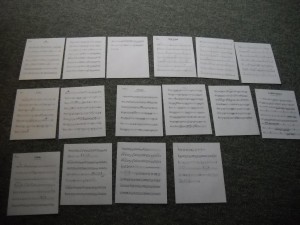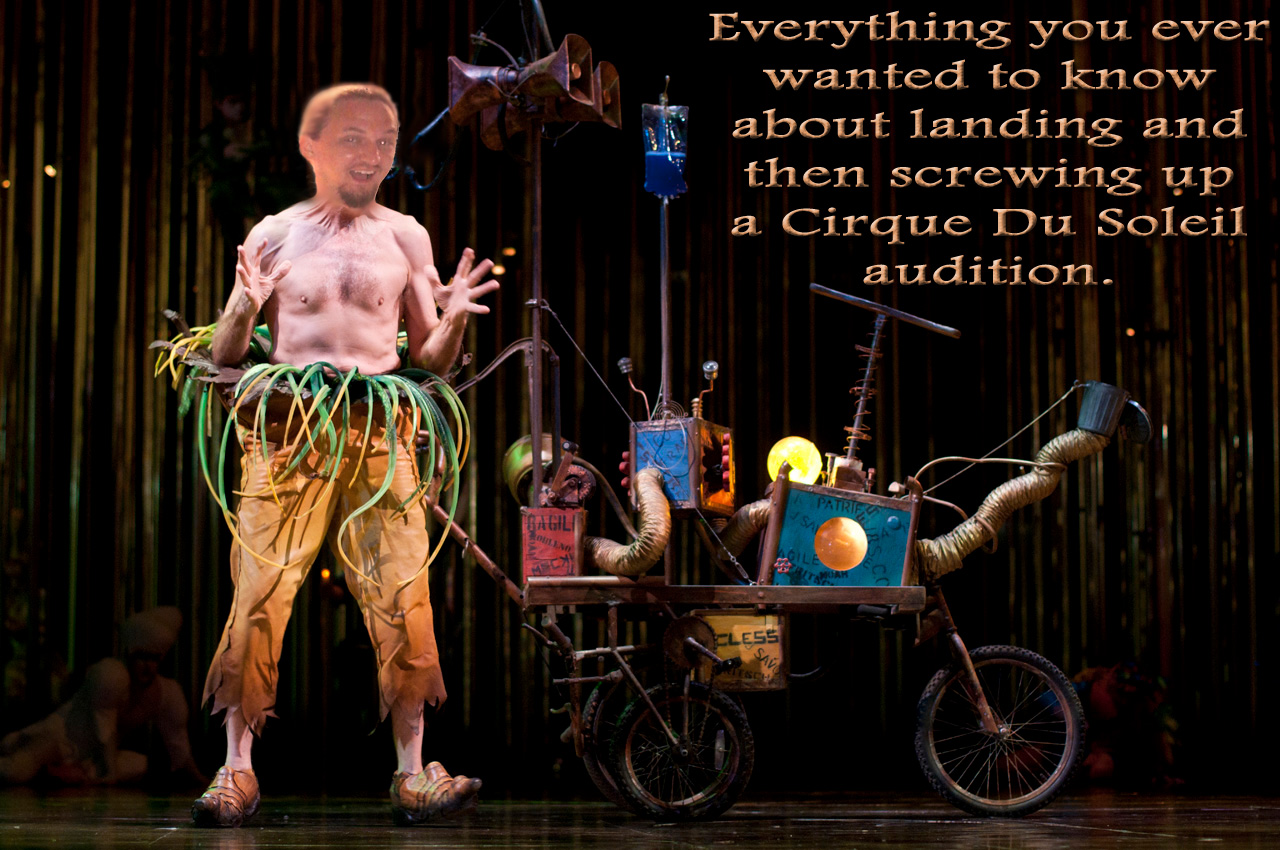I don’t know what it takes for an acrobat to get an invitation for a Cirque Du Soleil audition, but for me, a musician, it was quite a process. I’m sometimes asked about exactly what I did to get an invite, how I prepared myself, and how the audition actually went. Well, let me take a bit of time here to tell you how it all went down: where my interest in the cirque-style began, the process of getting their attention, and all the way down to the quiet drive back to my hotel room that evening in Austin, TX during SXSW.
My initial interest in Cirque Du Soleil began back in the early 2000’s when I happened upon a CD copy of “O” at Barnes & Noble. I bought the album without ever having seen a show or heard any of the music before. It just seemed like something different to sink my teeth into. Plus, I had always had an interest in what exactly Cirque Du Soleil was all about, having seen clips on the TV. I always try to discover new music and not just listen to rock all the time. I think it’s important to expand your horizons. You can only do so much in music if you only listen to King Diamond and Megadeth.
Well, after hearing the album I went back to Barnes & Noble and bought up everything else they had on Cirque Du Soleil, including some DVDs. I really fell in love with what I saw and heard. The music was a mixture of new age, rock, world music and just about everything else out there. I started to wonder how a musician would get hooked up with an organization like that: did they have to live in the area, know somebody, did they need an agent? How can a guy from Louisiana get involved?
This would all be in the back of my mind for years. So let’s flash forward about a decade and skip over me getting fed up with playing local dive bars and metal shows. Let’s skip over me slogging it out in the Metal world and skip to when Cirque Du Soleil finally came to my city to perform at the Baton Rouge River Center. Finally, I’d get a chance to see a live show. So let’s flash forward about 10 years.
My friends and I got tickets for the show Alegria. When the time came to check out the show, I brought along some binoculars – not to see the show better, but to watch the bass player. I wanted to see if he was doing anything special in regards to performance or playing. For most of the show I simply sat in my seat and watched what the bass player was doing: sitting with the rest of the musicians, having little interaction with the show, and just playing his part. I thought it overall performance and sound was great. I also knew that it was something I could do.
So I decided then and there that I was going to pursue this. I was going to figure out what it took to land a gig with the company. I was going to go all out, aka balls to the wall.
The Alegria show happened in early January of 2011. I remember this because I would spend the rest of January and all of February that year working on a plan, and executing that plan, to ultimately get Cirque Du Soleil’s attention.
Here’s how it went:
I went to Cirque Du Soleil’s website and looked up their career opportunities. It directed me to a place where I could fine tune my job search depending on what exactly I specialized in. I selected the “on stage” option and selected my discipline as an instrumentalist – after all, I was a bass player. Yes, I play guitar, keyboards, drums and I’m also known as a vocalist, but, I’ve always been best at bass guitar. I’ve always considered myself to be a bass player (and a songwriter) first and foremost, and it’s the bass guitar that I would consider myself to be a professional. From there it took me to a place where it allowed me to select my main instrument I would be auditioning for. Then it gave me a set of guidelines that they were looking for in the person applying.
In short, there are three things they list for you to have ready when you apply with them: they want you to upload your CV, which is like a resume: where you’ve worked, what schools you’ve studied at, what other instruments you play, etc.; they want you to upload a couple of photos of yourself so they can see what you look like; last, but not least, your audio/video demo package.
Let’s look at the audio/video package.
For the audio/video demo part they provide a link for you to follow which will bring you to an area that is specialized to your instrument of expertise. It takes you to their FTP site where you can download a kit containing the songs for your instrument. This kit will contain two versions of each song they want you to learn, record, and then upload to them for review. Each song has a unique style and a different set of techniques so they can judge just how well rounded you are. As a bass player, they want to know that I can play thumb style, play with a pick, and play in a variety of genres, i.e. latin, jazz, rock, folk, etc.

Like I said, each song has two versions: the first version is a reference track that is the full audio performance; the second version has the instrument taken out (in my case the bass guitar is taken out) so they can hear your playing and not the recorded instrument playing. A click track and sheet music is included in both versions. At the time I went to the site they had songs for electric bass and songs for upright bass. Well, I wasn’t playing upright bass at the time so I just learned the songs for electric bass.
Just to sum up the criteria of what they want you to have when you go to apply: get a CV ready, get your photos ready, get your video/audio demos ready. Once you’ve got all your stuff in order you’re to upload all the material to their FTP site. This material will then be evaluated and they’ll determine whether or not you get into their database. The database is a list of people that they can call on to either audition, fill in for a job if they need it filled in quickly, or for whatever other reason (who the hell knows).
Okay, that’s the first part.
The second part is what some people neglect to check out. Yes, you can upload your videos and audio to the FTP site and then just sit around waiting for them to call you or you can look at the site a little further and see that you can also find auditions in your area and apply for those. And that is a whole OTHER set of things you have to go through.
Alright, so I’m looking at the site and I see all this stuff and I formulate a plan. My parents taught me a valuable lesson when I was a kid: they said if you’re ever going out for something—like if you’re running for class office—you should do something to get people’s attention: use loud colors and make your presentation stand out from the others. With that in mind I was determined to prove to Cirque Du Soleil that I wanted the job more than any of their other applicants. I was going to learn, and present to them, way more than they asked for; I was going to present it in a nice package; I was going to make all my material stand out. I was going to make myself stand out.
I set out to learn over a dozen songs from many of their shows, not just the 5 or 6 they had in their kit. I was going to video tape me performing these songs from multiple angles and put together a video package that looked better than anyone else’s video package. I was going to initiate way more work than most, if not all, musicians have done to audition for Cirque Du Soleil.
First things first. I went on YouTube and started looking up other people’s performances for their audition reel. Cirque Du Soleil’s FTP site allows you to either upload the footage to them or just link to an existing YouTube video. So there are a lot of videos for public viewing that you can look at for reference. Most people did the same thing in their audition videos: they stood in front of their amps and just played the song, recording it through the air into their video camcorders. If you’re playing bass then this is the worst thing you could do. The bass is a hard instrument to hear in the mix sometimes.
I basically saw that most people didn’t put a lot of time and care into their video performance footage. Why spend the time learning, fine tuning, and recording the songs if you don’t want to impress people? It seemed like they filmed themselves playing the songs on a whim and decided to put the videos out there just to see what happens. They weren’t getting themselves across in their performances. These people that are going to be judging your videos don’t know you; they don’t know what your capable of. You have to hit them over the head with an excellent presentation. You have to not only get your playing across but your personality as well. They have to be able to see you and hear you. With that in mind (and because of my work ethic) I decided that I was going to learn Adobe After Effects to learn how to make title screens, learn how to use Sony Vegas to edit video, buy a good video camera that shoots in HD, and figure out how to record my performance directly so that it would have the best audio quality.
Long story short, I figured out how to do all that.
Every two or three days I would learn a new song, practice it, figure out what I was going to do on it to give it my own personal stamp, and then spend a lot of time recording it for the best quality. This took a LOT of time. I didn’t want to just film in my home studio. I wanted to film at my planetarium, in my living room, in any place to vary the look of the videos up.
I can’t stress this enough. I spent a lot of time making sure that not only my audio performance was spot on but that the video footage looked really good. I wanted multiple angles so they could see all the cool stuff I was doing. Yes, it took a long time but I ultimately think it paid off.
I mean, look, most people come up with an idea in their head and they do the first thing that comes to mind. You have to realize that most people come up with the same ideas. So most people are doing to be doing the same thing. Translation, the people reviewing your material are going to be seeing the same thing over and over again. I wanted to stand out. So I made every effort to make my presentations unique.
Now, I didn’t want to upload ALL these videos to their FTP site. After all, at the time, they only allowed each new user a certain amount of space for their videos and audio samples.
Cirque Du Soleil not only wants you to upload the songs they have put in their kit for you to learn, but they also want one short video of you giving an introduction to yourself and why you want to work for them. Aside from that they also want a “personal performance” video of you playing anything else you’d like to show off – something to give them a little taste of what you’re made of. They’ll allow you to either upload this directly to their FTP site or you can provide a YouTube link. So in that personal performance video I included clips from all the songs I recorded. Then, in the clips, I included links to the full versions. So, if they were watching the video and saw that I was playing “Tundra Ballet” and wanted to see the full performance they could click on the link and watch it all the way through. YouTube allows you to make these annotations on your video to allow viewers to click on other videos you have. I took full use of that.
Let me just take a second to explain what I mean by this. I ended up filming 18 videos: 6 were from the kit and 12 were extras. I edited out all the best performance parts from the 12 extra videos and compiled them into two “personal performance” videos. I uploaded these two personal performance videos to YouTube. I then upload the full versions of all 18 videos. Then I went back to the two personal performance videos and put video annotations that would link the viewer to the full versions of the songs displayed in the edited clip.
But, like I said, I didn’t want to upload all these big videos to their FTP.
What I ended up doing was only uploading the tracks they wanted to their FTP site, i.e., the videos of the songs from their kit. I also uploaded my brief personal introduction, all my photos and my CV. All that was left was to upload my personal performance videos. For those I included just the YouTube links that would bring them to my edited performances of all the other songs I learned, which in turn, could take them to the full performances.
I did this for the general application submission. Now, for the audition application I found that I had to learn two other songs that weren’t in the original kit. Not a problem. I went ahead, learned those, recorded them, and submitted them as before: in total it was 4 videos from the original kit for general submission, 12 videos that I chose as my personal performance, and 2 additional videos for the audition application that weren’t in the original kit set list.
Okay, now I’ve submitted all the material requested to their general FTP site as well as submitted an application to their Austin audition dates. You see, in order to get an audition you have to get an invitation. You can’t just show up. This means they weed out the people they don’t think are worth their time.
But who does this? The Talent Scouts.
So I figured I better get the talent scouts’ attention.
I went on the Cirque Du Soleil website and found all of the talent scouts’ names. I then looked them up on Facebook and sent them each a personal message telling them that I’ve submitted an app for their Austin musician auditions. And, wouldn’t you know it, one of them actually got back to me. He said that he loved my videos and was pleased to see how well done they were. He applauded my extra effort I went through.
Yes, sometimes I go overboard with things. Sometimes I tell people this story and they say, “Dude, that’s ridiculous. You put in way too much work and effort for that.” But you know what, in this case, it paid off.
So if you’re sitting there thinking that I overdid things, you can think again.
My plan paid off. My great looking and great sounding videos got the attention of the talent scout that I had hounded down. “Expect an invitation soon,” he said.
And sure enough, in my email one day I got a personal invitation to come audition for them during the SXSW festival in Austin, TX.
End part 1
Tomorrow (03/19) I’ll post Part 2 which deals with the actual audition.
Stay tuned and subscribe to the blog over here on the right hand side ——>





